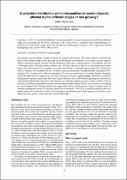| dc.identifier.citation | Nachuha, S. 2009. Is waterbird distribution within rice paddies of eastern Uganda affected by the different stages of rice growing? pp. 44–49. In: Harebottle, D.M., Craig. A.J.F.K., Anderson, M.D., Rakotomanana, H. & Muchai, M. (eds). Proceedings of the 12th Pan-African Ornithological Congress , 2008. Cape Town, Animal Demography Unit. (ISBN: 978-0-7992-2361-3) | en_US |
| dc.description.abstract | Rice paddies are becoming a common feature of Uganda’s landscapes. This study aimed to establish the
effect of the different stages of rice growing on the distribution of waterbirds in rice fields in eastern Uganda.
Spatial variation in species diversity and the abundance of the most common species was examined between
1) Ploughed fields, 2) Fields with rice at Phase one, 3) Fields with rice at Phase two, and 4) Harvested fields.
Eighty-two total counts of 26 4-ha plots were made, from which 43 waterbird species and 20,821 individuals
from 15 families were recorded. Of the 15 families censused, the family Threskiornithidae represented 30%,
Ardeidae 27%, Anatidae 16%, while the remaining 27% were accounted for by 12 waterbird families. Ploughed
fields and fields with rice at phase one were more species diverse and supported higher abundances of species
than phase two and harvested fields. The Cattle Egret (Bubulcus ibis), Yellow-billed Egret (Egretta intermedia),
African Open-billed Stork (Anastomus lamelligerus), the Little Egret (Egretta garzetta), Squacco Heron (Ardeola
ralloides), the Black-headed Heron (Ardea melanocephala) and the Grey Heron (Ardea cinerea) were among
the most common birds. Findings of this study suggest that the rice farming practice creates a simple mosaic of
habitats (heterogeneity) some of which are attractive to waterbirds. However, it is most likely that the observed
spatial pattern of waterbirds is related to the abundance and distribution of other factors such as food, water
depth and water quality, which were not tested by this study. | en_US |

